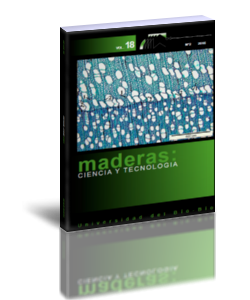Effect of the Brazilian thermal modification process on the chemical composition of Eucalyptus grandis juvenile wood - Part 1: Cell wall polymers and extractives contents
Keywords:
Extractives content, holocellulose, insoluble lignin, VAP HolzSysteme®.Abstract
This article reports the first study of the influence of the Brazilian process of thermal modification called VAP HolzSysteme® on the chemical composition of Eucalyptus wood. Flatsawn boards of Eucalyptus grandis juvenile wood were tested for four treatment levels: untreated and thermally modified at final cycle temperatures of 140, 160 and 180 °C. Chemical analyses were carried out according to the standards of the Technical Association of the Pulp and Paper Industry and encompassed total extractives, insoluble lignin, holocellulose (cellulose + hemicelluloses) and solvent soluble extractives in water (cold and hot) and ethanol:toluene (1:2 v.v.) mixture. The chemical composition of thermally modified Eucalyptus grandis juvenile wood was significantly changed by the VAP HolzSysteme® process compared to untreated wood. Only the wood thermally modified at final cycle temperature of 180 °C was significantly different for all the chemical analyses performed compared to untreated wood.Downloads
Download data is not yet available.
Downloads
How to Cite
Batista, D. C., Bolzón de Muñiz, G. I., da Silva Oliveira, J. T., Benigno Paes, J., & Nisgoski, S. (2016). Effect of the Brazilian thermal modification process on the chemical composition of Eucalyptus grandis juvenile wood - Part 1: Cell wall polymers and extractives contents. Maderas. Ciencia Y Tecnología, 18(2), 273–284. Retrieved from https://revistas.ubiobio.cl/index.php/MCT/article/view/2373
Issue
Section
Article

































